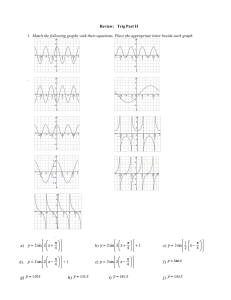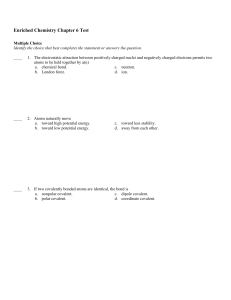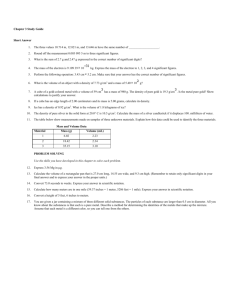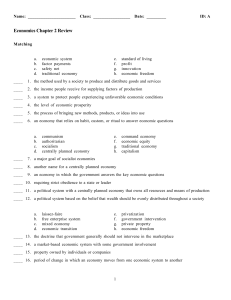ExamView - Untitled.tst
advertisement
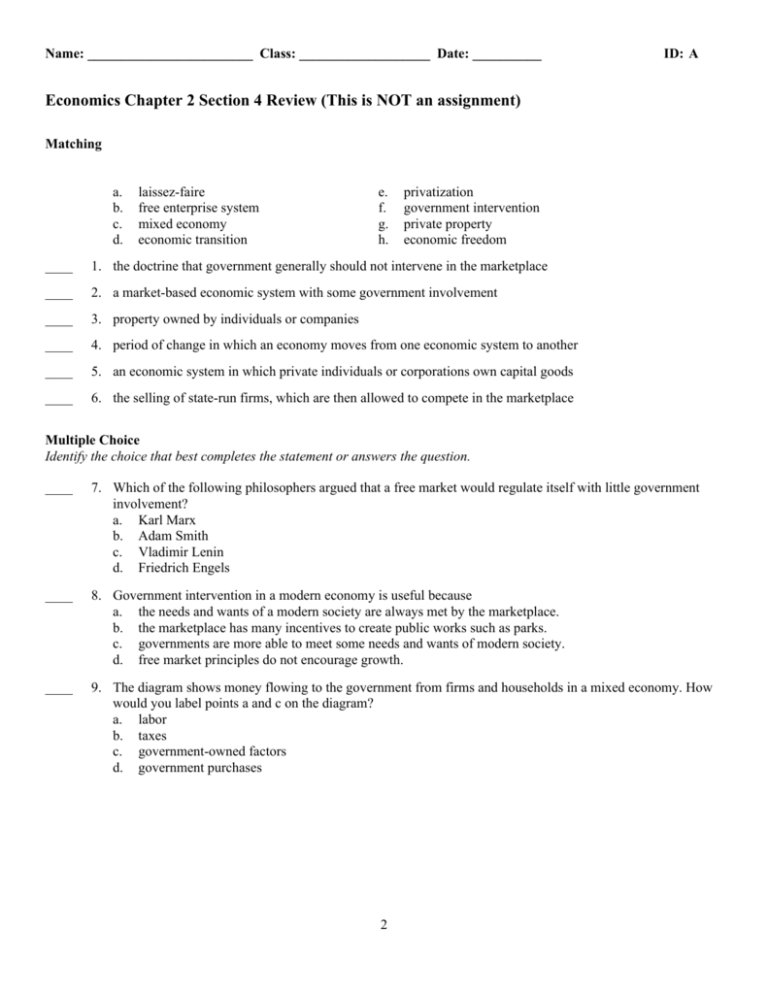
Name: ________________________ Class: ___________________ Date: __________ ID: A Economics Chapter 2 Section 4 Review (This is NOT an assignment) Matching a. b. c. d. laissez-faire free enterprise system mixed economy economic transition e. f. g. h. privatization government intervention private property economic freedom ____ 1. the doctrine that government generally should not intervene in the marketplace ____ 2. a market-based economic system with some government involvement ____ 3. property owned by individuals or companies ____ 4. period of change in which an economy moves from one economic system to another ____ 5. an economic system in which private individuals or corporations own capital goods ____ 6. the selling of state-run firms, which are then allowed to compete in the marketplace Multiple Choice Identify the choice that best completes the statement or answers the question. ____ 7. Which of the following philosophers argued that a free market would regulate itself with little government involvement? a. Karl Marx b. Adam Smith c. Vladimir Lenin d. Friedrich Engels ____ 8. Government intervention in a modern economy is useful because a. the needs and wants of a modern society are always met by the marketplace. b. the marketplace has many incentives to create public works such as parks. c. governments are more able to meet some needs and wants of modern society. d. free market principles do not encourage growth. ____ 9. The diagram shows money flowing to the government from firms and households in a mixed economy. How would you label points a and c on the diagram? a. labor b. taxes c. government-owned factors d. government purchases 2 Name: ________________________ ID: A ____ 10. Which of the following would be part of the flow indicated by the arrow labeled “b”? a. smoke alarms for senators’ offices b. Secret Service salaries c. import taxes paid by foreign firms d. Social Security checks ____ 11. In which of the following lists of mixed economies does the free market system dominate? a. France, Canada, South Africa, United Kingdom b. United States, United Kingdom, Singapore, Hong Kong c. Cuba, Greece, China, United States d. Russia, Peru, France, Canada ____ 12. The United States economy is a mixed economy a. based on a traditional economy, but allowing some government intervention. b. based on a centrally planned economy, but limiting government intervention. c. based on a free market, allowing no government intervention. d. based on a free market, but allowing some government intervention. ____ 13. The main difference between the economies of China and North Korea is that a. North Korea does not have a centrally-planned economy. b. North Korea has begun to introduce free market practices. c. China is privatizing state-run businesses. d. China does not allow ownership of private property. 2 Name: ________________________ ID: A ____ 14. The United States government intervenes in the economy in order to a. provide competition for private firms. b. impose barriers on foreign trade. c. promote the general welfare. d. protect laissez-faire. ____ 15. Which of the following best describes the economy of the United States? a. free market b. centrally planned c. mixed, but more centrally planned d. mixed, but more like a free market Short Answer : You MUST complete TWO QUESTIONS for FIVE POINTS EACH. Additional correct answers are worth one point extra credit. 16. List the following countries in order, starting with the most centrally planned and ending with the most free market: China, North Korea, Singapore, South Africa, United States. Name and give examples of two types of government intervention that you considered as you compared these countries. 17. The economy of China is in transition. What does this mean? 3 ID: A Economics Chapter 2 Section 4 Review (This is NOT an assignment) Answer Section MATCHING 1. ANS: A PTS: 2 DIF: L3 REF: A.40 OBJ: 2.4.4 Describe the role of free enterprise in the United States economy. STA: B.2 TOP: Economic Systems | Laissez-Faire 2. ANS: C PTS: 2 DIF: L3 REF: A.41 OBJ: 2.4.1 Explain the rise of mixed economic systems. TOP: Economic Systems | Mixed Economy 3. ANS: G PTS: 2 DIF: L3 REF: A.41 OBJ: 2.4.1 Explain the rise of mixed economic systems. TOP: Economic Systems | Private Property 4. ANS: D PTS: 2 DIF: L3 REF: A.43 OBJ: 2.4.3 Compare the mixed economies of various nations along a continuum between centrally planned and free market systems. STA: F.3 TOP: Economic Systems | Economic Transitions 5. ANS: B PTS: 2 DIF: L3 REF: A.43 OBJ: 2.4.4 Describe the role of free enterprise in the United States economy. STA: B.2 TOP: Economic Systems | Free Enterprise 6. ANS: E PTS: 2 DIF: L3 REF: A.43 OBJ: 2.4.1 Explain the rise of mixed economic systems. TOP: Economic Systems | Privatization MULTIPLE CHOICE 7. ANS: B Early free market thinkers such as Adam Smith believed that, if left alone, the free market would provide the greatest benefit for consumers. PTS: 3 DIF: L3 REF: A.39 OBJ: 2.4.1 Explain the rise of mixed economic systems. TOP: Economic Systems | Free Market Economy 8. ANS: C Some needs of modern society would be difficult to meet in the marketplace. PTS: 3 DIF: L3 REF: A.40 OBJ: 2.4.1 Explain the rise of mixed economic systems. TOP: Economic Systems | Government Intervention 9. ANS: B In a mixed economy, the government collects taxes from both households and firms. PTS: 5 DIF: L4 REF: A.40 OBJ: 2.4.2 Interpret a circular flow model of a mixed economy. TOP: Economic Systems | Mixed Economies 1 ID: A 10. ANS: A The government purchases goods such as smoke alarms from businesses. PTS: 5 DIF: L4 REF: A.41 OBJ: 2.4.2 Interpret a circular flow model of a mixed economy. TOP: Economic Systems | Mixed Economies 11. ANS: B On a continuum of mixed economies, the free market dominates in the United Kingdom, Canada, United States, Hong Kong, and Singapore. PTS: 3 DIF: L3 REF: A.41 OBJ: 2.4.3 Compare the mixed economies of various nations along a continuum between centrally planned and free market systems. STA: F.3 TOP: Economic Systems | Mixed Economies 12. ANS: D The U.S. economy is a mixed economy with a free market system and limited government intervention. PTS: 3 DIF: L3 REF: A.43 OBJ: 2.4.3 Compare the mixed economies of various nations along a continuum between centrally planned and free market systems. STA: F.3 TOP: Economic Systems | U.S. Economy 13. ANS: C China is in economic transition and is privatizing state-run businesses. PTS: 3 DIF: L3 REF: A.43 OBJ: 2.4.3 Compare the mixed economies of various nations along a continuum between centrally planned and free market systems. STA: F.3 TOP: Economic Systems | Privatization in China 14. ANS: C The United States intervenes to promote the general welfare and provide vital services. PTS: 3 DIF: L3 REF: A.43 OBJ: 2.4.3 Compare the mixed economies of various nations along a continuum between centrally planned and free market systems. STA: F.3 TOP: Economic Systems | Government 15. ANS: D While the United States economy is a mixed system, the foundation of the economy is the free market, so the resulting economy is mixed, on the side of the free market. PTS: 3 DIF: L3 REF: A.43 OBJ: 2.4.4 Describe the role of free enterprise in the United States economy. STA: B.2 TOP: Economic Systems | United States Economy 2 ID: A SHORT ANSWER 16. ANS: A list that goes from most to least centrally planned is North Korea, China, South Africa, United States, and Singapore. Two types of government intervention are government ownership of the factors of production and laws that protect the rights of private property owners. North Korea’s government, for example, owns all property and all economic output. The United States has laws that protect private property. PTS: 7 DIF: L4 REF: A.41 OBJ: 2.4.3 Compare the mixed economies of various nations along a continuum between centrally planned and free market systems. STA: F.3 TOP: Economic Systems | Mixed Economies 17. ANS: China’s economy is undergoing a period of change as it moves from central planning toward a market-based system. PTS: 5 DIF: L3 REF: A.43 OBJ: 2.4.1 Explain the rise of mixed economic systems. TOP: Economic Systems | Mixed Economies 3







